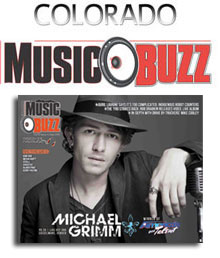The Manager’s Corner
by Chris Daniels
I’ve managed my own band for 30 years and I’m in the Colorado Music Hall of Fame. All that’s nice but today’s music business is changing at light-speed and you have to be more engaged in the ‘biz’ than ever. Some things have not changed, careers are still built on some tried and true elements: great music, performance and timing. But today’s artists must work harder than ever to succeed. The good news is that we have new tools to help young musicians grow their fan base. The book I wrote for the course I teach at CU Denver on artist management is called “DIY: You’re Not in it Alone.” While you are ultimately responsible for your own career, these days it’s essential to make the most of all the help that is offered along the way.
The glamorous business of rock n roll, right? Well maybe not. The nuts and bolts of that business are not very sexy, but the details are often the difference between getting paid and not receiving any revenue when a radio station or satellite radio network “spins your record.”
As artists, we tend to focus on the songs, recording the best vocal track, or getting a great mix, playing the best gigs and all the challenges of making a recording or giving a great performance. But there is more to it. Forty years ago you were lucky to get a record deal with a label that had the power to promote a single – getting you airplay on radio (called “spins”) and, hopefully, a position on the Top 100 Billboard chart. Disc Jockeys (DJs) wrote down what tracks they played and announced them on the radio and reported the spins to the various trade magazines and agencies (like ASCAP and other performing rights organizations) and that all generated revenue for the songwriter, the label, and artist. That success on radio made touring possible. That was the circle.
Slide the fader up forty years and everything is done digitally. And this is where the details matter. For those artists wishing to break out of Colorado – to get your recording to a larger market, to get paid when it is played on Sirius/XM and to have your internet success through YouTube and other social media leads to touring beyond our little island – there are a number of detailed technical issues you must address. This article will focus on three of them but there are many more. First, USIRC codes imbedded in your master for radio and internet tracking as well as SoundExchange payments to you for the spins. Second, if you are selling any kind of physical product, from t-shirts to CDs you will need UPC codes for SoundScan reporting and to make merch sales easier and faster. And before either of the first two steps can be applied to your CD you need to “master” your project.
I am assuming that everybody who reads this column knows what mastering is. But in the off chance that you don’t I will briefly explain. The reason I include this is because the USIRC codes are added to your song files during mastering. So, step one – mastering: Every track that you record in your home studio or your garage or even at one of the best studios in town has a number of characteristics that make up the unique sound of the record. These can be both positive and unique and negative and problematic for the listener. Specifically, that track that sounds so great in your home studio may, in fact, have a lower bass “punch” than similar tracks in the broader marketplace and genre of the music you play. There can be other characteristics that have to do with the instrumentation on the track, the kind of drum sound the engineer went for, the frequency ‘stacking’ in any given area of the song and the over all “level” of the master mix. For example a jazz tune with an acoustic stand-up bass is going to have a very different set of frequencies that are dominant in the recording compared to a project that uses a funk electric slap-bass or a hip-hop synth bass. The job of the mastering engineer is not to make the stand-up bass sound like the synth but to bring out all the frequencies that make each one unique to the instrument while simultaneously making it possible for the listener of KUVO’s jazz format – who then switches channels to KBCO to hear his or her favorite song by the Fray – able to listen to both without having to adjust all the settings on their radio to accommodate the two completely different song sounds and radio formats. It’s a pretty impressive trick of electronics and art when done right. In Colorado we have a number of studios that do mastering and one Grammy award winning “mastering lab” in Boulder. Airshow Mastering has won Grammy’s for their work mastering albums that range from early folk recordings to modern rock. It will cost you between $800 and about $2,000 depending on the number of tracks and the complexity of those recordings and it usually takes the better part of a day. But it is well worth it. Dominick, James, and David are some of the best mastering engineers anywhere in the country and if you have a project that is going to be getting national or international attention, talk to Airshow about mastering your record before you release it. There are others including Tom Capek at Colorado Sound, Jeff Merkel from 8 Houses Down in Denver and the good folks at the Blasting Room to mention only a few. A well-mastered recording will (a) sound better then the mix, (b) all the tracks on the album will “stand up” against other industry recorded tracks – meaning they will be comparable across sound pressure level (SPL) and frequency spectrum to any other track you hear on the internet or radio. (c) The time between the songs (usually about one or two seconds) will be calculated for the best “feel” between songs and the track will go to “absolute zero” when it is finished so that the CD player or iTunes store will read it as an individual track and not continuation of the previous track (d) it will sound “universally” fantastic on any medium on which it is played or streamed…whether it is your home studio or your friends 1975 Gremlin with a six-inch mono speaker in the center of the dashboard – your recording will sound balanced and clear in all those systems. Neat trick right?
During the mastering, a mastering lab like Airshow will want to know if you are going to generate USIRC codes to embed in the tracks. The simple answer is YES! (Sometimes the mastering lab can do the application for you – and they will embed the codes – but often you will do the paperwork yourself and send the lab the codes – oh the glamor) If you have ever wondered how your car radio knows it is Lake Street Dive on your car radio when it flashes the song title and artist, it is the USIRC codes. These codes also allow a radio station the ability to identify and track how many times your songs are played digitally (we don’t write it down in a log-book anymore). Those digital log-books GET YOU PAID for every spin on both terrestrial and satellite stations and networks as well as Pandora, Spotify, Rhapsody and on internet radio and sites like SoundCloud. These same little groovy codes are what SoundExchange uses to keep track of how many times and on what stations your internet songs get played. It also lets iTunes and Amazon know what songs got downloaded – and unlike streaming – that can add up to real money. If one million people stream your song on Spotify it is not much money (less than $3,000) but if that same song gets downloaded off iTunes one million times that is roughly $500,000 in revenue that you or your record company will collect = and it’s the USIRC code that makes that tracking possible. Starting to see why this is important?
Finally, just about everybody knows what a UPC code is. Every time you shop at the grocery store it is that little “barcode” that enables the scanner to read what brand of peanut butter you bought. On CDs and vinyl that barcode is scanned when you buy the new Weepies album at Twist & Shout and is automatically reported to SoundScan (note this is different than Sound Exchange) as a sale of one of their records. SoundScan uses it to count the number of sales an artist has. And you can set it up so that they will also track your sale of CDs at your merch table when you are touring! SoundScan reports that information to the trade magazines and the various reporting bodies that track an artist’s sales: like the RIAA and many others. Ever wonder how the RIAA knows when a record sold a million copies? It’s through SoundScan and those UPC codes. Billboard knows that Taylor Swift is the only artist to sell platinum so far in 2014. How do they know this? It’s her “analytics.” They are tracking her SoundScan AND her SoundExchange numbers – and UPC and ISRC codes make that tracking possible. Billboard gets that information from the RIAA and other analytics sources like Big Champaign (now owned by Live Nation) that are quantifying the numbers of her spins, streams, downloads and sales figures.
You can go directly to any number of internet sites for acquiring a bar code and a set of USIRC codes for your next record or you can use an aggregator that will do all the paperwork for you for about $200. It’s cheaper to do online direct (about $89 for USIRC codes and about $35 for a bar code) but sometimes it is worth the extra few dollars to have somebody walk them through the process. I’ve done it both ways. The point is to DO IT!
The reason that we know of the YouTube success of OKGo or the sales figures of Chemistry Club is because their sales and spins are being tracked using those digital codes. And here is the really important part. For a band just breaking out of the Denver music scene, like Chemistry Club – hoping for their big break with a tour, or a record deal from a major label, or hoping to attract good management – everybody is looking at their “analytics” = their numbers. The big-league manager wants to know if they can sell tickets, the big-league label wants to know how many spins and sales they have, and the major concert promoter wants to know how many butts they can put in his/her venue. IT’S NOT JUST ABOUT FACEBOOK ‘LIKES’ OR followers on Twitter, it is about the analytics. And if you don’t have those codes embedded in the tracks and/or your UPC code and your recording is not mastered must constantly be turned up and/or down by a radio station or a fan while they are driving – you are not going to have any appeal to the “majors” of any kind and you will be missing out on revenue. It is a little “detail” that can mean a lot.
Category: Shop Talk






